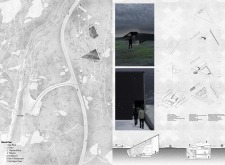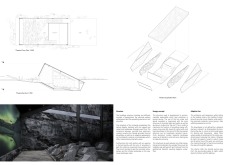5 key facts about this project
Sokkiö is an architectural project that serves as a sunken movie pavilion located in Iceland, specifically positioned near the Grotgatja Cave. The design effectively merges architectural innovation with the natural landscape, creating an immersive environment that enhances cinematic experiences. The pavilion's unique integration with the surrounding topography allows for a descent from the surrounding terrain into the microcosm of the pavilion, fostering a heightened sense of intimacy and focus on visual and auditory elements of film.
Architecturally, Sokkiö represents a commitment to contextual design, emphasizing the relationship between built form and natural environment. The structure's dynamic triangular roof not only provides aesthetic appeal but optimizes natural light capture, reducing the need for artificial lighting. The sunken nature of the pavilion contributes to its environmental considerations, as it maintains thermal stability and utilizes geothermal energy. These features collectively reinforce the pavilion's functional role as a space for film screenings and social gatherings.
Unique Design Approaches
Sokkiö distinguishes itself through its architectural language that embraces local materials and forms. The predominant use of precast concrete provides structural integrity while echoing the nearby geological formations. Aluminum cladding adds a modern touch and reflects the changing Icelandic light conditions, contributing to the pavilion's ever-evolving visual character. Glass panels are strategically placed to establish transparency, fostering a connection between the interior space and the exterior landscape.
The pavilion incorporates thoughtful spatial organization that enhances user experience. Essential components include a dedicated theatre space designed for film projection, with an acoustic backdrop crafted from natural rock. Areas for exhibitions and social interaction are seamlessly integrated, ensuring that the flow of movement is intuitive and engaging. This adaptability extends the functional scope of the pavilion beyond film screenings, positioning it as a versatile venue for various community events.
Environmental Considerations and Sustainability
Another significant aspect of Sokkiö is its approach to sustainability. The project utilizes geothermal heating sourced from the local environment, promoting energy efficiency and minimizing ecological impact. The careful design of the pavilion optimizes natural light, which not only enhances the aesthetic experience but also reduces reliance on electrical systems. This environmentally conscious approach reinforces the pavilion's role as a cultural hub that respects its natural context while fostering community engagement.
For further details on the architectural plans, sections, designs, and innovative ideas that define Sokkiö, readers are encouraged to explore the project's presentation. Understanding the nuances of material choices and spatial organization will provide deeper insights into the architectural intentions that underpin this unique movie pavilion.


























